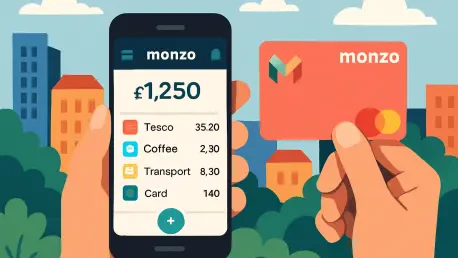Imagine a world where your bank not only manages your finances but also powers your mobile phone service with competitive pricing and innovative features tailored to your needs. This scenario is becoming a reality as Monzo, a leading U.K.-based fintech company, steps boldly into the telecom sector. With a customer base recently surpassing 13 million, including a significant spike of one million in the last quarter, Monzo is leveraging its digital prowess to diversify beyond traditional banking. By entering the mobile market as a mobile virtual network operator (MVNO), the company aims to utilize existing telecommunications infrastructure to offer unique services. This strategic move signals a potential shake-up for established telecom providers, challenging norms with a consumer-centric approach. As fintechs increasingly blur the lines between financial and non-financial services, Monzo’s expansion raises critical questions about the future of competition and innovation in the mobile industry.
Fintechs Redefining Industry Boundaries
Monzo’s venture into the mobile market exemplifies a growing trend among fintech companies to expand into adjacent sectors. This shift is driven by the need to diversify revenue streams and capitalize on large, loyal customer bases. Unlike traditional banks, fintechs like Monzo have the agility to innovate rapidly, addressing consumer pain points such as rigid mobile contracts and high roaming charges. By operating as an MVNO, Monzo can bypass the hefty costs of building its own network, instead partnering with existing providers to deliver services. This model not only reduces operational expenses but also positions the company to offer flexible plans that could appeal to cost-conscious users. The broader implication is a blurring of boundaries between financial services and other industries, as digital banks seek to become one-stop solutions for a range of consumer needs, potentially transforming how people interact with both banking and telecom services.
This trend of diversification is not unique to Monzo but reflects a wider movement within the fintech sector. Competitors such as Klarna and Revolut have similarly explored non-financial domains, recognizing the value of cross-selling opportunities to their existing users. Monzo’s explicit commitment to delivering mobile services “the Monzo way” suggests a focus on transparency and user empowerment, which could set a new standard in the telecom space. Industry observers note that such moves are fueled by rising consumer expectations for seamless, integrated digital experiences. As fintechs leverage their technological expertise and data-driven insights, they are well-positioned to challenge conventional players by offering tailored solutions that prioritize customer satisfaction. This dynamic signals a future where the overlap between sectors could redefine market competition, pushing traditional telecom firms to adapt or risk losing relevance in an increasingly digital landscape.
Competitive Pressures on Telecom Giants
The entry of Monzo into the mobile market is poised to create significant ripples among established telecom providers. By leveraging the MVNO model, the fintech can potentially undercut competitors on price while offering innovative features that resonate with modern consumers. This cost advantage stems from avoiding the infrastructure investments that burden traditional carriers, allowing for more aggressive pricing strategies. Industry analysts from firms like Assembly Research predict that such a move could reshape the British mobile market by introducing heightened competition. Telecom giants may find themselves forced to reevaluate their own pricing models and service packages to retain market share. The pressure to innovate will likely intensify as Monzo targets younger, tech-savvy demographics who prioritize flexibility and value, creating a challenging environment for incumbents accustomed to more static business models.
Beyond pricing, Monzo’s customer-centric ethos could further disrupt the telecom landscape. The company has built its reputation on addressing frustrations with traditional services, and this philosophy appears to extend to its mobile offerings. With a focus on simplifying contracts and enhancing user experience, Monzo may attract a segment of the market disillusioned with complex billing and poor customer support from legacy providers. This shift could catalyze a broader industry transformation, where consumer expectations for transparency and ease of use become non-negotiable. Established telecom firms might need to invest heavily in digital transformation and customer engagement strategies to keep pace. As fintechs continue to encroach on their territory, the competitive dynamics of the mobile market are likely to evolve, potentially leading to more consumer-friendly options and a redefinition of what constitutes value in telecommunications.
Evolving Partnerships in a Digital Era
Another dimension of Monzo’s mobile market entry is the evolving relationship between fintechs and other entities, including traditional financial institutions like credit unions. Rather than pure competition, there is a noticeable shift toward collaboration, driven by a shared goal of meeting heightened consumer demands for seamless digital solutions. Such partnerships enable fintechs to expand their reach while allowing traditional players to tap into cutting-edge technology and innovation. For Monzo, aligning with established telecom infrastructure providers as an MVNO is a prime example of this synergy. These collaborations are reshaping the competitive landscape, fostering an environment where integration often yields greater benefits than rivalry. The result is a more interconnected ecosystem that prioritizes service enhancement and customer satisfaction over isolated growth.
This trend of collaboration also reflects a broader acceptance of integration across industries. As fintechs like Monzo diversify into telecoms, they bring with them a wealth of data and user insights that can be leveraged to create more personalized offerings. Traditional institutions, in turn, offer stability and infrastructure that fintechs can utilize to scale their operations efficiently. This mutual benefit is becoming a cornerstone of modern business strategies, particularly in sectors undergoing rapid digital transformation. For the telecom industry, such partnerships could lead to innovative service models that blend financial and communication solutions, offering consumers a more holistic experience. As these alliances grow, they are likely to drive further innovation, challenging all players to rethink how they deliver value in an increasingly interconnected market environment.
Shaping the Future of Consumer Services
Reflecting on Monzo’s bold step into the mobile market, it’s clear that this move marks a pivotal moment for both the fintech and telecom sectors. The strategic decision to operate as an MVNO allows Monzo to challenge established norms with a focus on competitive pricing and customer empowerment. This expansion not only highlights the growing overlap between financial and non-financial services but also sets a precedent for how digital banks could influence adjacent industries. Looking ahead, the industry must consider how to balance innovation with sustainability, ensuring that consumer benefits remain at the forefront. Telecom providers might explore strategic alliances or invest in digital upgrades to counter such disruptions. Meanwhile, regulators could play a key role in fostering fair competition while protecting user interests. As the boundaries between sectors continue to blur, staying attuned to evolving market dynamics and consumer needs will be essential for all stakeholders aiming to thrive in this transformed landscape.









